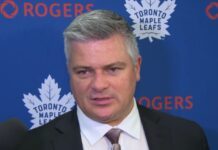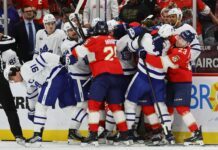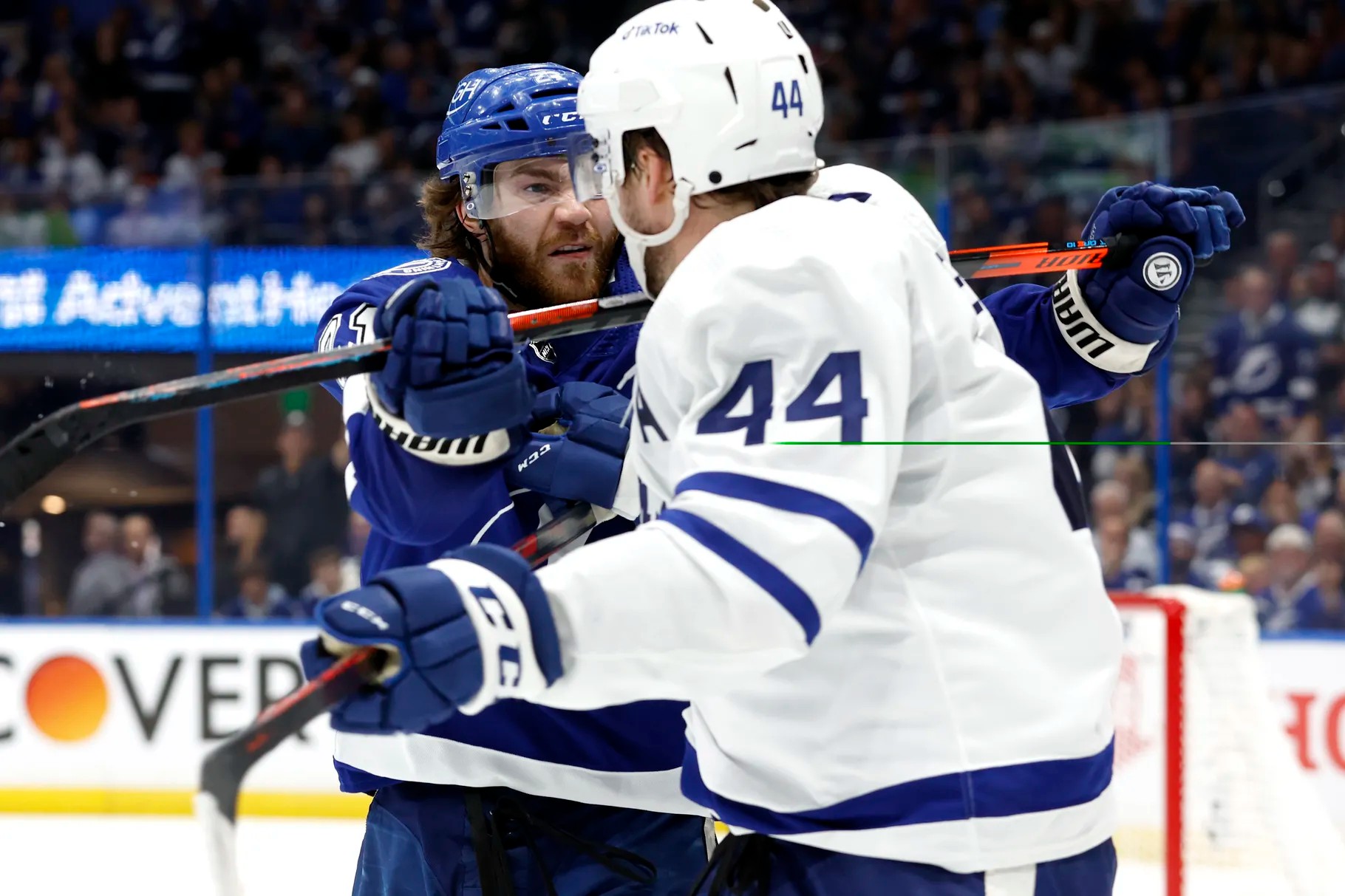The Stanley Cup Playoffs are all about finding ways to win, even on nights when you aren’t dictating play. The Toronto Maple Leafs did that on Saturday night.
Toronto got out to a hot start, scoring the opening goal only a few minutes in, and they held a 2-1 lead late in the first period. Things spiraled significantly in the second period. By the time a brawl erupted in the third period, the Leafs found themselves down 3-2, getting caved in for minutes on end, and hanging around in the game because of their goalie.
A late goal by Ryan O’Reilly with the net empty tied it and then further great goaltending in overtime gave Morgan Rielly enough time to find the back of the net. In the process, Toronto stole a game with a 4-3 victory and snagged a hugely important 2-1 series lead with a win on the road.
Turning Points
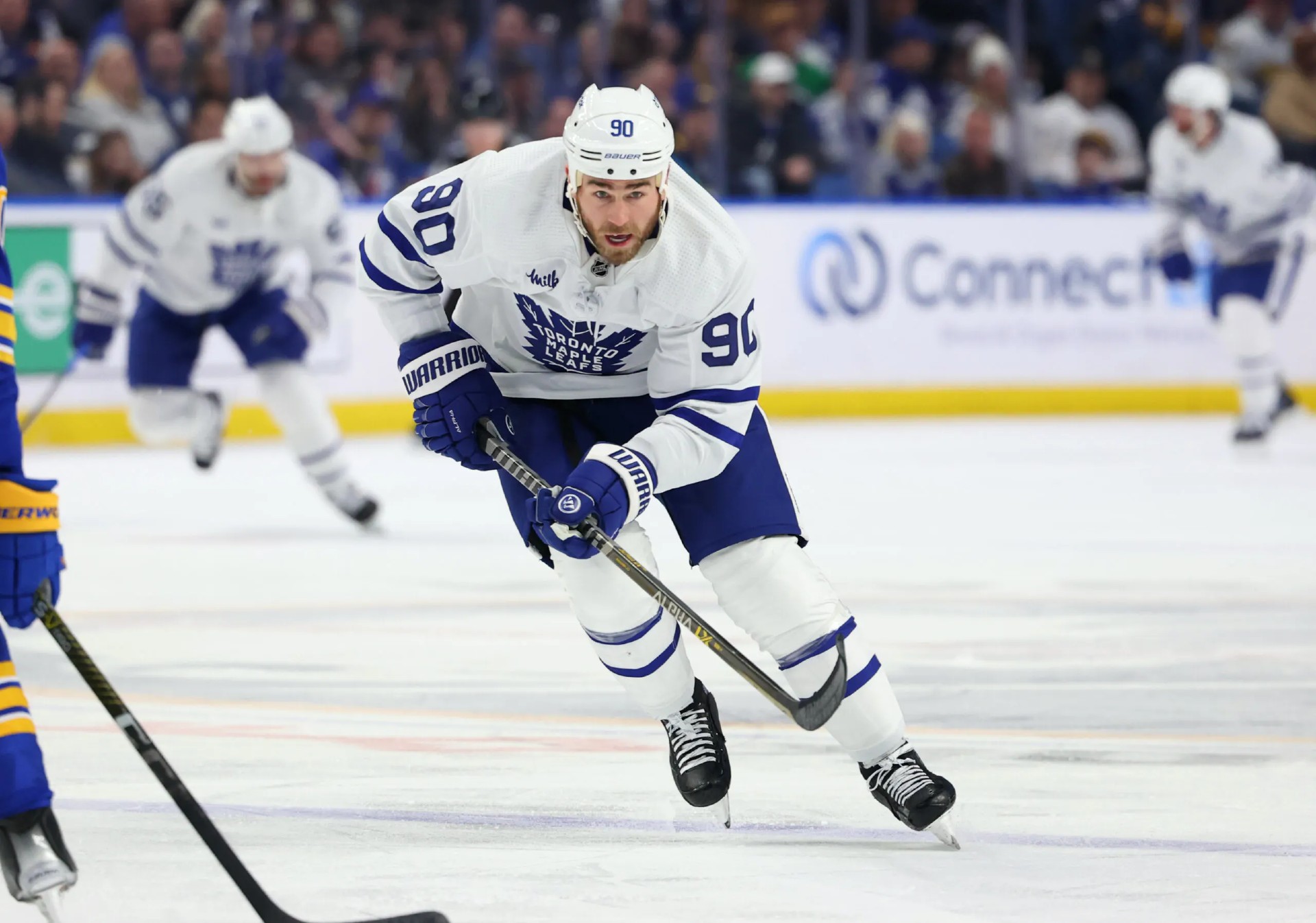
The first turning point of the game came late in the first period, with Toronto holding a one-goal advantage. They went on the PK after an offensive zone penalty taken by John Tavares, a hooking call that gave the dangerous Tampa Bay power play their second advantage of the opening period.
Yet again, the Leafs did an admirable job of killing it off — getting Tavares out of the box — but as an old friend once told me, your penalty kill is not over until you get the first change back at 5v5. The Leafs hadn’t gotten to that point yet; the puck was still in the Toronto end, and the team was still on the defensive.
Tampa Bay forward Brandon Hagel unleashed a wicked set of dekes to undress Ryan O’Reilly and put the puck behind the net to Corey Perry. Hagel darted to the far side and Ilya Samsonov lost complete awareness of where the puck was. When Perry made the pass to Hagel on the wing, Samsonov was looking at the other half of the ice, exposing the net. Hagel’s shot was not a good one — lost in the body of Samsonov — but while the Leaf goalie was down on the ice, his movement knocked it into his own net.
With just 32 seconds left in the first period, the game was now tied and the Leafs had blown their second one-goal lead of the opening period, squandering an opportunity to take control of a game when Andrei Vasilevskiy appeared vulnerable.
This turning point signifies when the game turned. After a competitive first period, the Maple Leafs were hemmed in nearly constantly from that point forward. The territorial battle was in the Toronto end continuously, but Samsonov — looked shaky and uncomfortable in the first — elevated his game to MVP-calibre. Following the Hagel goal, Samsonov stopped 25 of 26 Lightning shots the remainder of the game to steal Toronto a win.
Some of those shots came in the early second period, which is itself a mini-turning point. The Leafs were caught in a long change after the first shift of the middle stanza, setting up a breakaway for Tanner Jeannot, but Samsonov shut it down. Jeannot got another look all alone just a few seconds later, and Samsonov committed highway robbery on Victor Hedman on the same shift. Those saves helped get Samsonov going and kept the Leafs in it. He’d keep it going for the remainder of the evening.
The final two turning points are rather obvious: the tying and go-ahead goals. Toronto’s equalizer came with exactly one minute to go, only a few minutes after the Leafs finally emerged from their 35-minute-long coma and decided to press more on the forecheck.
Sheldon Keefe pulled Samsonov for the extra skater and got set up at 6v5 in the offensive zone (after a sneaky good play by Morgan Rielly to turn the puck over at center ice and set up the entry). Mitch Marner went down the wall to William Nylander, who gestured ever so slightly to fake out Mikhail Sergachev, who appeared to think Nylander was looking for Matthew Knies in the slot. Instead, Nylander put it on net looking for a rebound, and Ryan O’Reilly held perfect positioning on Ian Cole, poking the loose puck under the arm of Vasilevskiy. The Leafs were still alive.
Which led to the game-winning goal, coming after Samsonov made several more great stops in OT. The Leafs were winning very few faceoffs cleanly and had mostly neglected the task of merely getting pucks on goal through much of the game, but then both issues were corrected on one magical play.
O’Reilly won a draw back cleanly to Morgan Rielly, who walked in a couple of paces and lofted a weak wrist shot that meandered its way through a few bodies and surprised Vasilevskiy, over the shoulder and under the bar.
It was pure ecstasy, and the Leafs had stolen a game in Tampa… a potential turning point of the entire series.
Notable Performances
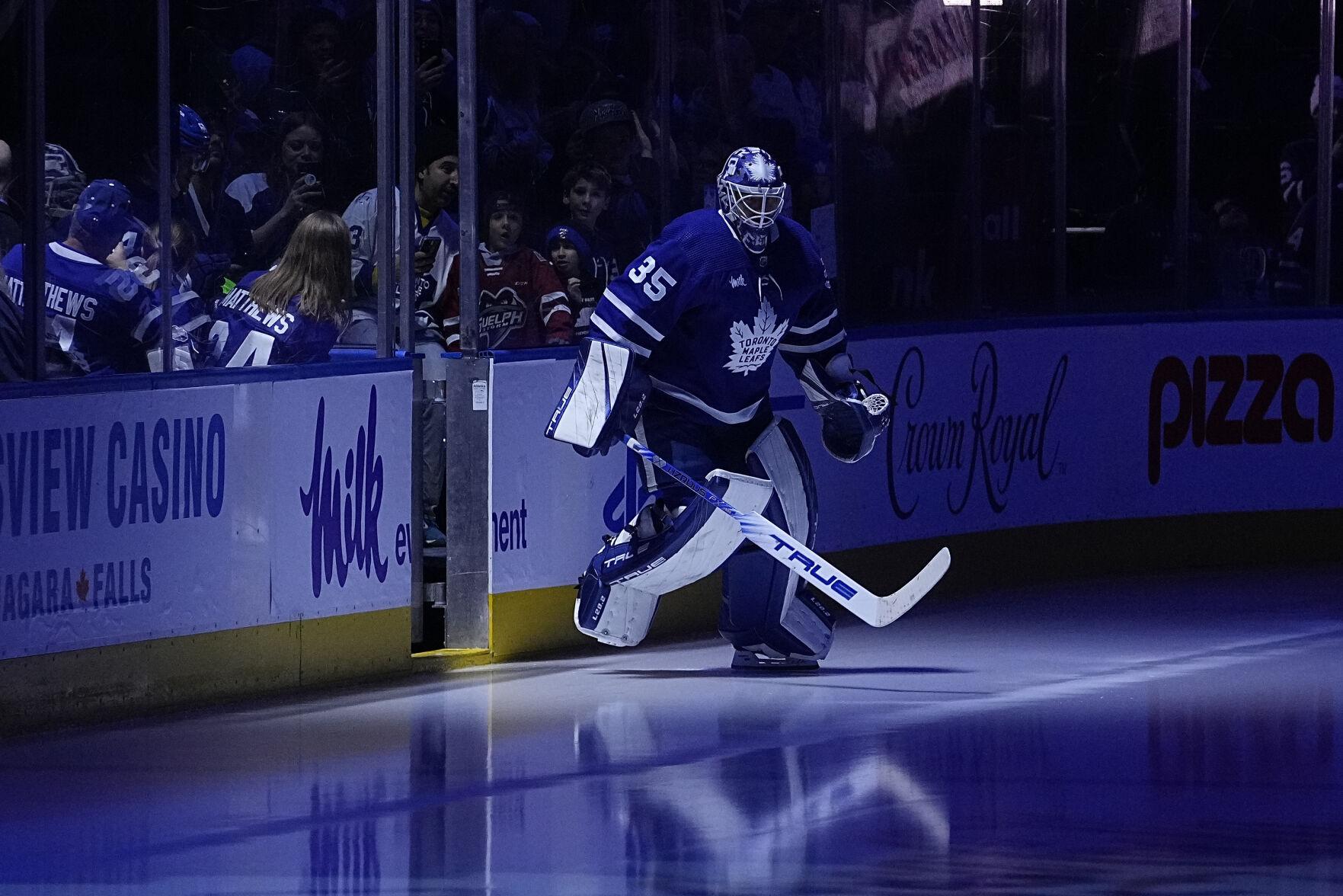
Ilya Samsonov was the player of the game for the Leafs, so he ought to be the guy we start with. The Russian goalie was phenomenal for Toronto and the most humorous part of it is how iffy he was in the first period. Discussions permeated around the fanbase about the possibility of Joe Woll seeing meaningful minutes at some point in the series during that first intermission break, and I don’t think the discourse around it was all that crazy. Samsonov was really poor in game one and only needed to be average in Game 2, so after a first period where he let in two goals — the latter of which was a display of poor goaltending — his resume in the series to that point wasn’t overly convincing.
And then the switch flipped. The next 59 minutes were lights out — the goalie we’ve seen all regular season — and he was the first Leafs netminder to steal a game since either Frederik Andersen’s Game 5 of 2018 or James Reimer’s Game 6 of 2013. Samsonov made somewhere between seven and 10 big-time saves from the second period through OT, all of which would have lost the game for the Leafs if they’d gone in.
Toronto was dead in the water, and Samsonov fished them out and brought them to calm sea with his steady presence. It was the definition of a goalie bailout. To win a Cup — or even just to go far in the playoffs — a team needs some of those. We’ll get into this later from the Vasilevskiy angle, but to this point, Samsonov has been the better goalie, largely because of Game 3.
Unfortunately, Samsonov is one of only a couple of happy notable performances tonight. If we want to give a little more praise, Ryan O’Reilly deserves a lot of it. He spent a lot of the game in his own end — as everyone on the Leafs did — but he got an assist on the opening goal from Acciari, scored a massive goal to tie it late, and won the faceoff and thus got the primary assist on the Morgan Rielly winner in OT.
O’Reilly recovered pucks very well all night long, won 62% of his faceoffs, collected three points, and won positioning on Cole in order to secure the tying OT goal. He has an edge to his game — a willingness to roll around in the mud — that the Leafs have lacked in the playoffs for years. It was noticeable in this game.
His linemate Matthew Knies deserves a bit of praise, too. Knies got his first playoff point on the Acciari goal, went on a solo rush at the end of the second period where he got in tight on Vasilevskiy, and he was one of the only Leafs to be creating much of anything in the third period. That earned him the right to take shifts with the big boys and be out there in the 6v5 situation late. Knies is quickly becoming one of Toronto’s six best forwards in this series.
Morgan Rielly should get an acknowledgment for his OT winner — yet another great moment for Rielly in the postseason, but his overall game was choppy. He did nothing wrong on the hit on Brayden Point that ignited the brawl, but I had Rielly down for several turnovers in his own end — which didn’t make him alone among Leafs D, but he had his fair share of issues. Luke Schenn, his defense-mate, may have been Toronto’s best defenseman. He was calm and poised under pressure when the puck was on his stick for a player not necessarily known for any of that. That said, both players failed to cut off a pass on the first Tampa goal coming off a quick entry to the offensive zone.
The line of Auston Matthews, Mitch Marner, and Calle Järnkrok was the only one not getting caved in according to the underlying numbers — and they did create a goal, a shot that Marner jackhammered from the point and Matthews deflected in. I said in the last piece that Matthews needed to start scoring goals, so it is a start. However, I thought this group could’ve been more dominant on both ends of the ice. They were better than the other lines, but that wasn’t saying a whole lot.
This is when the notes turn negative. The line of William Nylander, John Tavares, and Alex Kerfoot, one that your author has long been skeptical of, was not particularly great. They were hemmed in too many times and were burned on the first Tampa goal. In particular, Nylander was burned not back-checking hard enough on Cirelli.
Nylander’s night was a bit of a rollercoaster. There were some very concerning moments on defense like the previously mentioned one, but there were also quite a few offensive chances (the only Leaf you could say that about). He led the team with seven shots on goal, including several off the rush. Nylander was notable at least, which is something you could not say for Tavares and Kerfoot, who were invisible on first watch and even worse on re-watch. That group has to be better in Game 4.
The same could be said about the fourth line of David Kämpf, Zach Aston-Reese, and Sam Lafferty, which did nothing on offense and were hemmed in frequently in the defensive zone.
Jake McCabe and TJ Brodie on defense were also very rough — Brodie, in particular. Turnovers were frequent from the usually steady defenseman — one of which came on the penalty kill that nearly resulted in a goal for Brayden Point — but the referees lost sight of the puck and blew it dead.
McCabe was significantly better, but he still had an ugly play when he whiffed on a check on Darren Radysh, allowing him to curl around the net and rip the go-ahead goal by Samsonov in the second period.
Mark Giordano was not as noticeable as he was in Games 1-2 (which was not a good noticeable), but he was abused by Nikita Kucherov in overtime for a chance that would’ve ended the game if not for Samsonov’s thievery.
Justin Holl is perhaps the only other argument for best Leafs D besides Schenn thanks to two drawn penalties, both of which on the PK, in addition to his typical shot-blocking ability as the designated player tasked with getting drilled by the Stamkos one-timer. However, he also made a very poor decision to dangle the puck rather than shoot on a chance in OT, turning it over with three forwards deep and creating a 2v1 for Tampa, which again the Lightning couldn’t convert on.
Storylines for Game 4
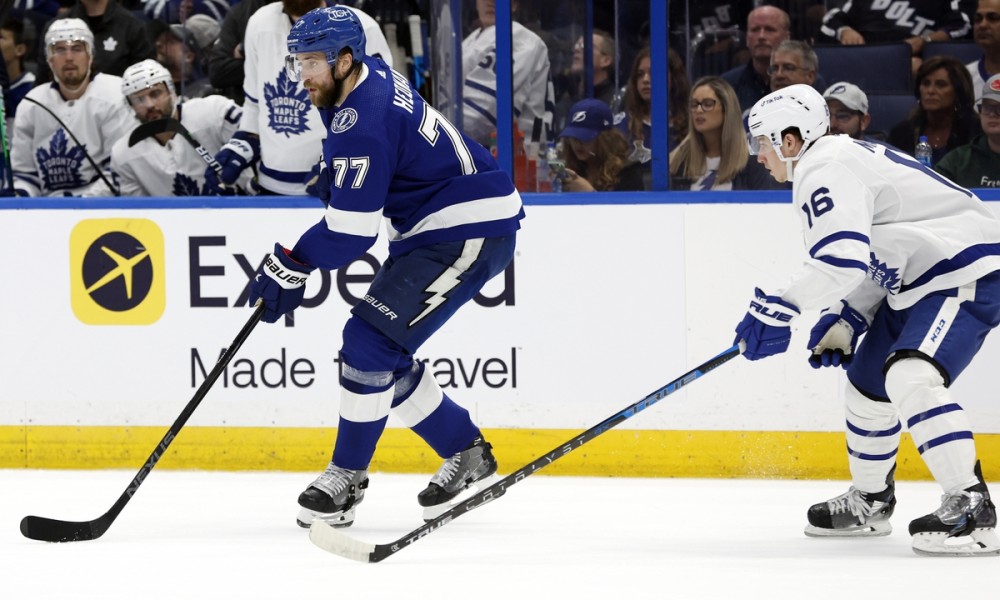
1. Tampa’s forechecking pressure. The Lightning’s response to their difficulty with the Toronto cycle in Game 2 was to never let it get set up by making the Leafs play almost entirely in their own end.
The biggest thing I noticed on re-watch of this game was how passive the Leafs were in their neutral-zone forecheck and how quick they were to collapse on the slot in the defensive zone. There was little pressure on the puck or high in the zone; just four or five skaters all standing in the slot or around the net like it were a penalty kill. It had the advantage of limited scoring chances, but that’s its only advantage. Otherwise, it allows the opposition to cycle around endlessly, shooting and retrieving over and over again. By the time the Leafs recovered possession, they were just chipping the puck out, going for a change, and it was right back to defense.
This was tactical of course, too. The Lightning ramped up their forecheck pressure in this game, sending two and three forwards deep in the offensive zone along with a highly activate defense. You could count on two hands the number of times in 79 minutes of hockey that a Leaf defenseman had more than a second to stand stationary on the puck in their own end.
That includes even if the Leafs were behind their own net, while the teams were changing. Even in that instance, Cooper was sending F1 to flush the puck carrier out from behind the net. There was no time to think; bang-bang decisions were necessary. That’s what caused so many turnovers as the Maple Leafs looked really uncomfortable.
Worth noting: Sheldon Keefe has emphasized that even though Tampa’s season didn’t look as strong in the standings this season, they remain one of the very best forechecking teams in the league (a comment seemingly based on the privately-tracked metrics the team has available to them).
Game 4 will be all about how the Leafs answer. They need to have their breakouts ready and down to a tee. Defensemen need to be prepared for quick passes or be willing to skate it out. Chips and rims up the wall should be in the back pocket, but possession exits should be the priority.
Toronto needs to be more aggressive up ice to not let themselves get buried too much, too. They also need to check much tighter in the neutral zone. It will alleviate some of the pressure from the Tampa forecheck on the Leafs’ breakouts if they disrupt more plays at the DZ blue line and get a cycle going in the OZ.
2. Lineup changes for the Leafs? The Leafs rolled with the same lineup in G3 that they did for G2 — an obvious choice to make after a dominant G2. Now, they’re coming off a game where they got beat up, even if Samsonov won them the game. Adjustments are much more understandable.
My opinion has long been that Marner and Tavares, as well as Nylander and Matthews, are the optimal combinations for the top two lines given what we saw this season, but Sheldon Keefe has remained insistent on jamming Tavares and Nylander together. Does that mean they’ll try a different winger besides Alex Kerfoot with #88 and #91? How about down in the lineup? Could we see a change to the fourth line, after a very poor showing in Game 4?
I’m not sure we will see any changes, to be honest. It felt less like particular vulnerabilities with the lineup were exposed and more that the entire team played poorly and got caved in accordingly. Keefe may choose to give them another chance to play much better as a unit, using what was learned about Tampa’s forecheck pressure to adjust. But we will have to wait and see.
3. The mental response for both teams. Game 3 was an odd one because the worse team won — something that happens plenty in the regular season, but it is a legitimate paradigm shifter in a playoff series. Steven Stamkos was quoted after the game saying that his team “deserved to win,” which I found rather interesting.
Combined with ire from the Tampa Bay coaches and fans at the refereeing, the Lightning will need to lean on their experience, settle back down, and get their minds back in check. They can’t come into Game 4 feeling like they got ripped off because they won’t be mentally in the game. The Bolts also have to fight the temptation to get down on themselves after not winning when they threw their best punch of the series, one of the best they’ve thrown all season. I’ve watched the Lightning play a ton this year; that was one of the best games I’ve seen their top line play against a playoff-calibre opponent all year.
Likewise, for the Leafs the task is capitalizing on the gift they were given. Given recent Maple Leaf playoff history, during the third period of Game 3, my expectation was a loss and for a desperate Leafs team to come out strong in Game 4 looking to even the series. This era of the Leafs tends to alternate good and bad playoff games, and they tend to come back with lots of fire after an embarrassing loss (see: Game 2 of this series).
Game 3 was going to be embarrassing had the comeback never materialized. Instead, the team picked up a win, but they did so while playing (largely) poorly. What comes next?
I have no idea. The Leafs win so few of those kinds of games in the playoffs. What they ought to do is come out just as fiery as if they lost. They need to play with the hunger to fix the errors of Game 3 regardless of the outcome. Don’t let off the gas and be content with a split in Tampa.
4. The physical side of things. This series has gotten increasingly physical and chippy, and we can expect that to continue into Game 4. The Rielly hit on Point — an unfortunate collision from two players legally jockeying for position at a high rate of speed — should not have caused a donnybrook, but it did.
The Lightning have looked to impose their physical will on the Leafs in each game of this series and the Leafs have answered. We had the Bunting major penalty and suspension in Game 1, multiple fights in Game 2, and an all-out melee in Game 3. Beyond that, we’ve had Leaf fans taunting Lightning players in the penalty box in Game 2 and Lightning fans taunting Kyle Dubas (and Dubas returning the favor).
This series is already far more heated and emotional than last season with genuine vitriol bubbling in this rivalry. How will this affect Game 4? It’s one of the biggest storylines.
5. Andrei Vasilevskiy vs. Ilya Samsonov. I noted after Game 2 that Andrei Vasilevskiy has not looked consistently great against the Maple Leafs for two seasons now dating back to last regular season. That continued in Game 3 with another poor game from the vaunted goalie. The Leafs scored twice on shots from up high (one of which deflected) and hit a post from there, too. They scored on their only odd-man rush, and O’Reilly squeaked a puck by the goalie in tight to tie it.
For the game, Vasilevskiy graded out well below water in advanced metrics like GSAx on the heels of a dreadful Game 2. On Evolving Hockey’s GSAx leaderboard of all playoff goalies through three games, Vasilevskiy ranks dead last. Even a quick peek at something boring like SV% (.853) would reveal that Vasilevskiy has not been good. I expect Vasilevskiy will improve, which is why it was so massive that the Leafs won another game in which he was off his game.
For Ilya Samsonov, the question is if the corner has been turned. He was wobbly in the first period, but the past two games as a whole have been strong (56/61, .918, +1.19 GSAx). That’s the guy we’ve seen in the regular season, and if he continues building forward in a positive direction, the Leafs will be in a good position.
The goalie battle was going to define this series. Right now, Samsonov is winning it. Toronto can play significantly better in front of him, which is a reason for optimism for Leaf fans. The biggest reason for hope among Lightning fans is a better Vasilevskiy is possible, too. Or maybe it isn’t. Maybe he is tired and worn down from so much hockey over the past four seasons. Only time will tell.





